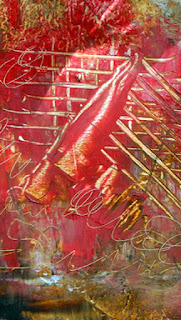 | |||
| "Wetlands" (detail) ©MMSikes |
When I was spending two years at Virginia Commonwealth University, earning my Master's Degree in Painting, we had a different artist each semester who came and worked with us in a big former public school building near the college. This visiting artist, also, had a large studio classroom in which to work. There were 12 of us, each with our own studio room, so we had an ideal working situation. While I was there, three of our visiting artists were from New York City; the fourth came from California.
One of the New York artists talked at length about the artist's mark.
Mark-making was especially important for her, and her remarks make an impression on me to this day. At the time I was working a lot with pastels, and painting with pastels is mostly mark-making for me. The three large acrylic paintings that I am currently working on in my studio all are filled with my marks. (See the detail from "Wetlands", above.) The visiting artist insisted that an observer can tell who the artist is by the marks they make.
Perhaps.
Today, so many artists use a variety of tools for their mark-making--found objects, wooden skewers, credit cards, etc. That's especially true when working with oil and cold wax, one of my favorite mediums. Now, I'm not sure the artist marks are as distinctive as before. Next time I'm in an art gallery, I'm going to look around with mark-making in mind.
What do you think about mark-making in a piece of art?
Mary Montague Sikes
https://artstore.marymontaguesikes.com
www.MontiSikes.com






